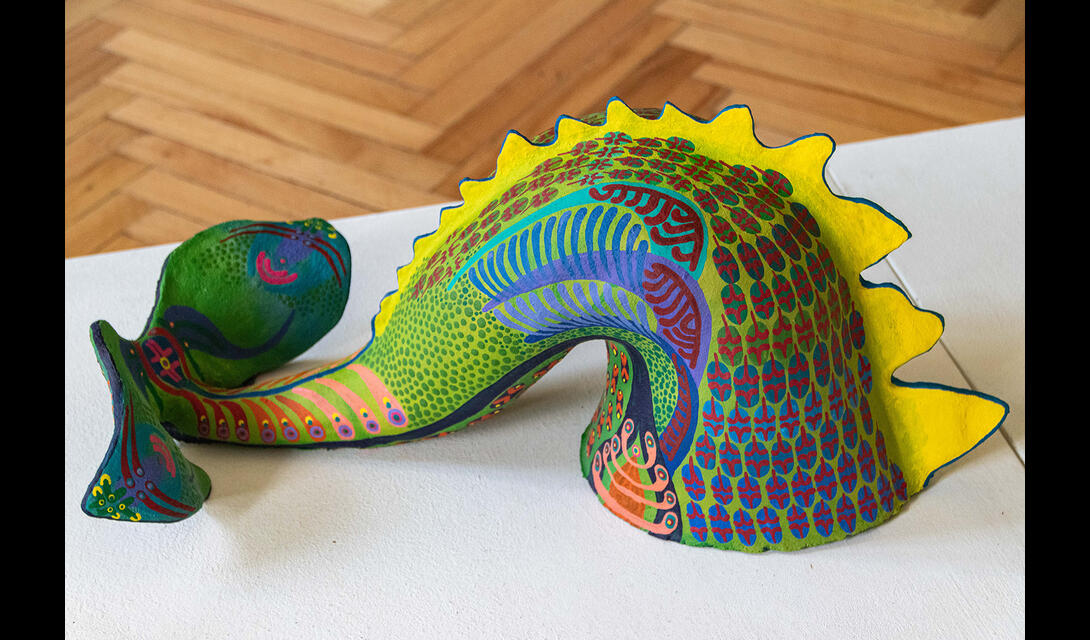Works
MY BEAUTIFUL OHO. KEEPER OF LEGENDS
Shamot clay, firing, hand modelling.
Ceramics. Author's painting. 2024
My Beautiful OHO is a story about a scientist born in a small village in Slobozhanshchyna who became a world-renowned and respected authority in his field. The Keeper of Legends embodies an underwater creature resembling the Loch Ness Monster, which, however, does not threaten lives and bears no evil, hence it is affectionately called "OHO" by the people. Its nature is shrouded in mystery, and no one knows if it truly exists. This creature symbolises the power of myths and legends that form the foundation of a nation's historical memory. It is the custodian of ancient knowledge, an embodiment of national identity, and a guardian of our land and cultural heritage.
Myths and legends become an act of resistance and self-preservation, preserving important knowledge and spiritual values. They not only reflect history but also create a foundation for national self-determination. In the age of post-truth, when facts are easily distorted, turning to myths gains special significance. The Keeper of Legends embodies the memory of an era when a boy from the family of an Orthodox priest, born in the village of Koziyivka in the Kharkiv province, became the founder of scientific ichthyology in Transcarpathia and is still considered the father of modern ichthyology. My Beautiful OHO tells of the spiritual and cultural achievements of our people, reminding us that history is not just a collection of facts but also a tapestry of legends passed down through generations, shaping the national spirit.
LIVING HERITAGE
Video performance
This video is a poignant and profound reflection on Ukrainian identity, standing at the crossroads between modernity and tradition, peace and war.
On the streets, mostly women are visible, behind the wheels of cars passing by, more and more women, while women in the village are selling cows and starting to work in factories in cities, citing a shortage of people, with fewer and fewer men.
A local resident laments that women now have to do everything; they are even invited to work as drivers because they are “more reliable.” For a small village in Ternopil, where hard work has traditionally suited men, this causes a palpable discomfort, disrupting the established order. Yet, the woman holds her ground.
An elegant, delicate girl in an evening dress, with exquisite makeup and barefoot, walks on the grass to feed her beloved animal, bringing it a gift, seeking support in domestic magic.
This image represents beauty and refinement, resilience and strength of spirit; she proudly and confidently performs her ritual. Ukrainians, in times of war, show the world that even amid ruins and trials, one can preserve humanity and inner light.
The goat being fed by the girl is a symbol of fertility and connection with deceased ancestors, as well as a familiar local animal. Feeding the goat bread is an act of care and love—for one's own, for the fertile land, for one's roots and traditions—appeasing death that lurks at every turn.
The contrast between the refined modern girl and the rural setting with its established algorithms and rituals serves as a representation of Ukrainian identity. Ukraine is a country where modernity intertwines with ancient knowledge, where traditions are preserved and passed down from generation to generation. This heritage lives in the hearts of people, even as the outside world changes.
The video also serves as a reminder of current events, of the war that has robbed millions of Ukrainians of their peace, while thousands have fallen in battles or perished from enemy bombardments. Yet, in these frames, there is hope that despite all hardships, peace and harmony will return to Ukrainian soil. It is a reminder that the true strength of a people lies not only in their ability to fight but also in their capacity to preserve humanity, culture, and beauty even in the toughest times.
This video is a message to the whole world, an invitation to see Ukraine not only through the lens of war but also through the prism of its indomitable spirit, rich culture, and endless beauty.
CONSERVATION
Installation.
The project presents an installation that reflects the concept of living heritage and cultural traditions through the prism of artifacts found in the territory of the Krasnokutsk community. The central element is an old wooden shelf, evoking associations with those that once stood in the pantries of Ukrainian homes. However, instead of the usual jars of jam and compote, this shelf displays objects: beetles, water from a lake, dried flowers and herbs, as well as traditional dishes such as baked goods. For me, they embody both material and immaterial cultural heritage.
Material cultural heritage includes physical objects that have historical, artistic, or cultural significance. In this project, each artifact tells its own story, leading us to a deeper understanding of the life and values of the community. At the same time, immaterial cultural heritage encompasses the traditions, rituals, knowledge, and practices passed down from generation to generation, creating a unique cultural code for the community.
This installation becomes particularly relevant in the context of the ongoing war in Ukraine. The war threatens not only the physical lives of people but also cultural treasures that may be lost or forgotten. Through artifacts symbolising both immaterial and material heritage, the project emphasises the importance of preserving cultural identity even in the most challenging times. It urges viewers to reflect on the significance of safeguarding and passing on this knowledge, rituals, and traditions, as they serve as living testimonies to the indomitable spirit and resilience of the Ukrainian people.
This installation acts as a form of protection against forgetfulness, preserving not only objects but also memories, emotions, and connections to the past. It shows that heritage is not merely an object but a living force that helps us withstand the challenges of modernity while preserving our culture and history.









